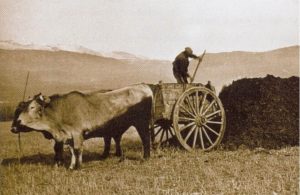
25 Sep Hidden in plain sight: Native Roots
The popular phrase “follow the money” is what people recommend when you are trying to get to the bottom of a suspicious matter. What if, instead, we follow the words? What truths can words reveal? Last night, as I was cooking a huge pot of chili, I realized sometimes a word or a name can reveal a world of secrets that are hidden in plain sight. As court interpreters, sometimes we miss something that may be just below the surface. Someone who has been labeled as a Spanish speaker and might actually be a speaker of one of the many indigenous tongues spoken across the continent we now call America. Let me share with you an anecdote about chili cooking and identifying speakers of Native American languages.
Being a chili enthusiast, I decided to sign up for a chili-cooking competition for a fundraising event. The cooks in this chili cook-off were asked to accompany their dish with a story or with some information for the chili tasters. So, I dove into the web in search of a story for my pot of chili.
I found articles, videos, and podcasts about the origin of chili. I already knew the actual name of the dish is chile con carne, Spanish for “peppers with meat.” Not surprisingly, most sources claim chili was born in Texas when that state was still part of Mexico. I found mentions of a Spanish nun who had some sort of out-of-body experience, crossed the Atlantic to evangelize Natives, and in turn, received a chili recipe from the Jumano people who lived in the Southern United States and Northern Mexico. I had to do a separate search for the Jumano people and found a rich history of several tribes, each with their own language and lifestyle, as well as a controversy about who can be called Jumano. Click here if you want to know more. Other sources point to the writings of Fray Bernardino de Sahagún describing dishes prepared with peppers and meat enjoyed by the inhabitants of Tenochtitlán, a place that is now called Mexico City.
 In any case, the focus on the origin of chili on all the sources I found was centered on gold miners, Texans, religious figures, and the chili queens of San Antonio, Texas, in the 1860s. I decided to look into the name and what that could tell me. As it turns out, “chili” or “chilli” is a Náhuatl word meaning “pepper.” If peppers existed in and around Mexico before they were spread over the world, then chili, even when it’s made with beef, an ingredient we got from Europe, seems to have strong Native roots. Some people are like that, too: you might not think they have strong Native roots, and yet they do.
In any case, the focus on the origin of chili on all the sources I found was centered on gold miners, Texans, religious figures, and the chili queens of San Antonio, Texas, in the 1860s. I decided to look into the name and what that could tell me. As it turns out, “chili” or “chilli” is a Náhuatl word meaning “pepper.” If peppers existed in and around Mexico before they were spread over the world, then chili, even when it’s made with beef, an ingredient we got from Europe, seems to have strong Native roots. Some people are like that, too: you might not think they have strong Native roots, and yet they do.
As a court interpreter in Wisconsin, I have encountered many speakers of indigenous languages over the years. They usually come form rural communities in Mexico, Guatemala, and other countries. They grew up having little contact with the Spanish language. Some leave their communities to go to a city where Spanish is spoken, or sometimes they immigrate straight to the United States, where they come into contact with Spanish speakers at work and where they live. The experience of being immersed in three linguistic environments can develop incredible trilingual abilities in some people. I once met a man who grew up speaking Zapoteco (a language of Oaxaca, Mexico), then learned Spanish, and ultimately became fluent in English. He has an outstanding ability for language learning.
Not all speakers of indigenous languages are gifted with a brain that soaks up languages so easily. Or if they do have that type of brain, they may have lacked the proper learning environment. Sometimes, people that have traveled from one linguistic community to another become a sort of language puzzle: they have some comprehension and communication abilities in two or three languages. Comprehension and communication are maximized if they can use every one of their languages in a situation. In court, relay consecutive interpretation works best to ensure comprehension in situations like this.
 If you’ve never worked or lived in a place where you frequently encounter speakers of indigenous languages, it might be hard to recognize them. People who speak Spanish as a second language will almost never self-identify as speakers of an indigenous language. Historically, they have experienced racism and have been marginalized for not speaking Spanish. When in court with a Spanish-language interpreter, they are unlikely to come forward and say “Spanish is not my main language” or “I don’t understand.” How should interpreters know, then? Look at the last names. Could those be indigenous last names? Don’t be fooled; people with the most Spanish-sounding names can be non-Spanish speakers.
If you’ve never worked or lived in a place where you frequently encounter speakers of indigenous languages, it might be hard to recognize them. People who speak Spanish as a second language will almost never self-identify as speakers of an indigenous language. Historically, they have experienced racism and have been marginalized for not speaking Spanish. When in court with a Spanish-language interpreter, they are unlikely to come forward and say “Spanish is not my main language” or “I don’t understand.” How should interpreters know, then? Look at the last names. Could those be indigenous last names? Don’t be fooled; people with the most Spanish-sounding names can be non-Spanish speakers.
Pay attention to people’s reactions and listen to their speech patterns. Do they have a different intonation? Can they pronounce all the words? What about the grammar? If something seems a little different, just ask: “¿Qué más habla?” (“What else do you speak?”). Thank you to a Spanish-language Federally Certified interpreter who works in California for suggesting this simple question. I wish I could tell you his name, but I can’t remember it. If somebody reading this attended a presentation about relay interpreting for Spanish at the NAJIT conference in June, maybe you know whom I’m referring to.
Let’s keep this conversation going; there is much work to be done educating the courts, attorneys, and ourselves. And do indicate in the comments section if you want to know how my chili rated at the competition.
Reme Bashi has been a certified court interpreter in Wisconsin since 2008. She began her career as an interpreter and translator in Mexico, at the University of Veracruz, where she majored in pedagogy. Being bilingual in English and Spanish lead her to language teaching and then to translation and interpreting. She was a conference interpreter for several years, interpreting for the media and government events in Mexico.
In the Midwest, Bashi has interpreted in a variety of settings – education, manufacturing, legal, and community. When she’s not interpreting, she likes to learn about new subjects, something that she considers pivotal to becoming a more proficient language access professional. Recently she has immersed herself in hospitality, urban gardening, and ancestry research. Contact: reme_sullivan@yahoo.com
Featured photo “Teotihuacan – Oaxaca” by Ulf Laube at www.ulf-laube.de, under a CC BY-NC-SA 3.0 license. Blog-post photos: from “VENTA DE BUEY” by JUANJO at Pitillas, under a CC BY-NC-SA 3.0 license; “El sabor de México // Bodegón de Chiles” by Armando Aguayo Rivera at flickr, under a CC BY 2.0 license.


Thank you Reme, interesting and sweet article. Spanish is my C language, and love to read about the different types of Spanish. I am for the preservation of indigenous languages and dialect, and I am too a forever learner. I am an Italian interpreter and Sicilian a dialect but also a language. Love to cook and savor other ethnicities taste and recipes. Yes, I like chili a lot and would like to know your recipes!
I want to put you in touch with a friend of mine that has an idea in mind because I think you could help coordinate this project aimed at indigenous language interpreters. Remind me Friday.
I love the mouth watering blogs, Reme! And history is my one true love so you offer an irresistible combination. Thanks for sharing all the insight.
Hello, Carmen! Thank you for your comment. It’s good to be reminded there are many languages spoken in places where we may think it’s only one. I’d love to know what Sicilian sounds like!
I’ll share my Chili recipe soon. Stay tuned!
Thanks for such an encouraging comment, Hilda! I’ll remind you to get me in touch with your friend!